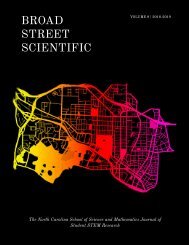Broad Street Scientific Journal 2020
You also want an ePaper? Increase the reach of your titles
YUMPU automatically turns print PDFs into web optimized ePapers that Google loves.
creasing tissue damage in rats with ischemia-reperfusion
injury [21]. Pyrvinium salts have been shown to inhibit the
growth of cancer cells [10]. Additionally, Pyrvinium has
been shown to be an effective anthelmintic, a drug used to
treat infections of animals with parasitic worms [22].
the other hand, if worms are exposed to increasing concentrations
of Pyrvinium, they will display higher rates of
neurodegeneration due to CK1α activation and inhibited
Wnt/β-Catenin signaling. Furthermore, if worms are exposed
to respective treatments during development, their
neurodegeneration rates will increase or decrease more
drastically compared to adult worms who are not exposed
to any treatment.
Figure 4. Pyrvinium Structure, (C26H28N3 + ). Formula
Weight: 382.53
1.4 – C. Elegans Model
C. elegans is a popular model for neurodegenerative
research. The transparency of C. elegans makes it easy to
facilitate the study of specific neurons and genetic manipulation
[11]. C. elegans also present locomotor behavioral responses
to neurodegeneration. The identification of genes
that cause monogenic forms of PD allows for easy modeling
in C. elegans. Studying a C. elegans model of PD can provide
insight into the cellular and molecular pathways involved
in human disease. C. elegans are also able to be used
to identify disease markers and test potential treatments.
Outcome measures are used to detect disease modifiers
such as survival of dopamine neurons, dopamine dependent
behaviors, mitochondrial morphology and function,
and resistance to stress. Behavioral markers studied in C.
elegans to detect PD include basal slowing, ethanol preference,
area restricted searching, swimming induced paralysis,
and accumulation of α-synuclein [12]. Dopamine
neuron location sites are present within hermaphroditic
and male specific worms (Fig. 5). This project will further
investigate the role of C. elegans in neurodegenerative research
in place of previously used vertebrate models.
1.5 – Hypothesis
Due to the significant role Wnt/β-Catenin signaling
plays for DA neuron differentiation in development, activated
signaling within worms will decrease neurodegeneration
rates. Thus, if worms are exposed to increasing
concentrations of Wnt Agonist 1, they will display lower
rates of neurodegeneration due to activated Wnt/β-Catenin
signaling and increased β-Catenin expression. On
Figure 5. Top represents a hermaphrodite C. elegans
and bottom represents a male C. elegans with their respective
DA neuron sites. R&L stands for right and
left side. CEPD neurons are mechanosensory neurons.
ADE neurons are anterior deirid neurons. PDE
neurons are post embryonically born posterior deirid
neurons. All neurons have DOP-2 dopamine receptor.
R5a, R7a, and R9a neurons are male specific
sensory ray neurons [25].
2. Methods
This study consists of a preliminary experiment, two
main experiments, and a secondary experiment. The two
C. elegans strains used in this project were the OW13 and
N2 type worms. OW13 overexpressed alpha-synuclein
and displayed PD-like symptoms. N2 worms acted as the
control group, representing wildtypes with no genetic alterations.
The same treatments were administered to both
worms for each of the following experiments. Treatments
administered included three separate concentrations of
Wnt Agonist 1 and Pyrvinium, as well as dimethyl sulfoxide
(DMSO).
2.1 – C. elegans Maintenance
N2 and OW13 strains were purchased from the
Caenorhabditis Genetics Center (CGC) at the University
of Minnesota. The CGC is funded by the National Institute
of Health (P40 OD010440). Worms were placed on
nematode growth media (NGM) plates that were spotted
with approximately 30μl solution of LB Broth and
OP50, a strain of E. coli in the C. elegans diet. Worms were
placed onto new plates approximately every 48-72 hours.
C. elegans maintenance protocols were followed through
WormBook [13].
12 | 2019-2020 | Broad Street Scientific BIOLOGY




